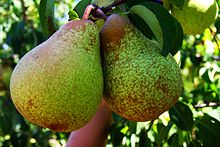| 'Rocha' Pear | |
|---|---|
 Portuguese grown 'Rocha' Pear | |
| Genus | Pyrus |
| Species | Pyrus communis |
| Cultivar | 'Rocha' |
| Origin | Sintra, Portugal |
Pêra Rocha (Portuguese pronunciation: [ˈpeɾɐ ˈʁɔʃɐ]; literally "rock pear", [1]) is a native Portuguese variety of pear. The earliest account of the Rocha variety dates from 1836, in the Sintra municipality. This variety was casually obtained from a seed, on Pedro António Rocha's farm. [2] The variety derives its name from his family name. The 'Rocha' pear is produced in several places in Portugal. The production area is over 100 square kilometres (39 sq mi) and there are about 9,450 producers. [3]
Pêra Rocha do Oeste DOP
'Rocha' Pear produced in the Oeste region of Portugal has a PDO status since 2003. [4] It is the most renowned, being a product with specific characteristics:
- Size: medium 55 mm to 75 mm
- Format: oval, piriform
- Skin: fine and smooth
- Colour: yellow and green
- Russeting: typical around peduncle
- Pulp Colour: white
- Pulp: hard and firm, crunchy, juicy and sweet
- 'Rocha' pear is very sensitive to pear scab ( Venturia pyrina) and also to Stemphylium vesicarium.
Over 13,520,000 kg of Oeste’s 'Rocha' Pear was exported in 2004 to countries like Britain, Brazil, France, Ireland, Russia, Poland, the Netherlands, Canada and Spain.
See also
References
- ^ "History" (in Portuguese). ferreiradasilva.pt. Retrieved 5 January 2017.
- ^ "The Rocha Pear, a taste of Portugal". 1883magazine.com. Archived from the original on 6 January 2017. Retrieved 5 January 2017.
- ^ J.M. Silva; N.G. Barba; M.T. Barros; A. Torres-Paulo (2005-04-30). "Rocha', the Pear from Portugal". Acta Hort. (ISHS) 671. pp. 219–222. Retrieved 2010-09-15.
- ^ Pêra Rocha do Oeste in the DOOR database of the European Union. Retrieved 2014-03-16.
